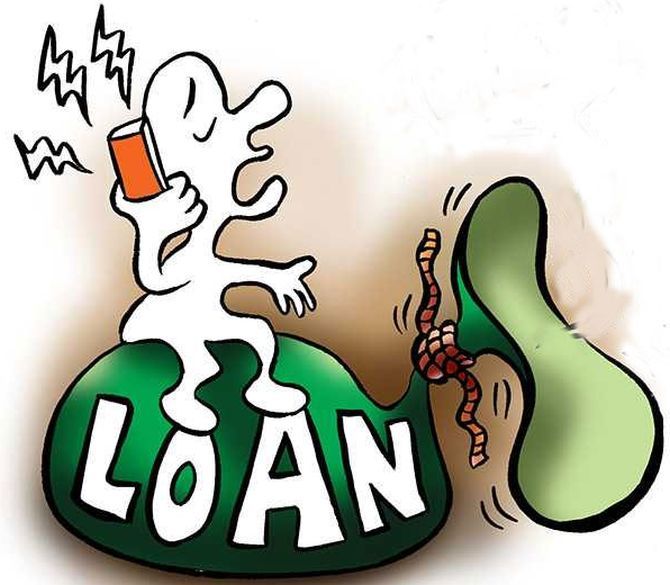'Usually, customers who don't get loans from banks approach NBFCs.'
'This is one reason NBFCs price their loans costlier than PSBs or private banks.'
'NBFCs will have higher delinquencies levels than private banks for most products.'

Abhay Kelkar, vice-president of research and consulting, at TransUnion CIBIL, agrees that a large portion of the money lent to borrowers could be at risk, but says India is nowhere close to a subprime credit bubble.
"There is some stress build up in case of NBFCs", Kelkar tells Rediff.com's Prasanna D Zore, hence "it is essential for lenders to carry out periodic monitoring of their portfolio and accordingly modify their risk management policies."
TransUnion CIBIL's quarterly India Industry Report (IIR; external link) -- that summarises trends and provides insights on the Indian consumer lending businesses -- for the fourth quarter of 2018 reveals that while delinquency rates for 'most major retail lending products declined or remained relatively stable over the year ended Q4 2018, indicating that consumers continue to do a good job of managing their credit obligations,' delinquency rates in the loans against property (LAP), 'saw a year-over-year increase of 53 bps (100 basis points = one per cent).'
TransUnion CIBIL, one of the largest credit information companies in India, categorises borrowers broadly into four different categories and assigns credit scores to each of these four.
Higher the scores, lower are the chances of these borrowers turning delinquent or failing to repay their loan EMIs and vice versa.
Right at the top of this category are the Prime plus borrowers having credit scores between 801 and 900, followed by Prime borrowers with credit scores between 751 and 800; next in this list are Near prime borrowers with scores between 651 and 700 and at the bottom of this categorisation are the Subprime borrowers with credit scores between 300 and 650.
The TransUnion CIBIL Industry Insights Report for the second quarter of 2019 mentioned that 'even though overall consumer credit delinquencies have remained largely stable through this slowdown, our data indicates there is some stress build-up in NBFCs.'
What are the stress build-ups that TransUnion CIBIL has noticed in the NBFC sector?
When we look at coincidental delinquency rates (delinquency rates at the end of a particular period; for the purpose of TransUnion CIBIL's IIR this period is the fourth quarter of 2018) for products like home loans, loan against property, personal loans and auto loans, we see that 90 days past due balance level delinquency rates for these products have gone up for the NBFC portfolio.
In addition to coincidental delinquency, we have also analysed vintage delinquency (analysis that studies delinquency within pools, for example, home loan, auto loan, credit card, LAP, etc).
Vintage delinquency looked at all accounts originated in Q2 2017 and Q2 2018 and compared 90+ delinquency rates of those new accounts after 12 months of activity.
Vintage analysis reveals that delinquency has gone up for smaller value personal loans (up to Rs 50,000) and smaller value auto loans (up to Rs 250,000) issued by NBFCs.
Smaller value personal and auto loans form almost 80% and 55% of new NBFC acquisitions respectively.
That is why we are saying that there is some stress build up in case of NBFCs.
What are the factors responsible for this stress build up?
One reason could be that as focus shifts to smaller value personal loans the customer segment also changes. We have mentioned in the report that almost 50% of NBFC personal loan originations in Q2 2019 were to borrowers in below-prime segments. This proportion has increased by 8.5% over Q2 2018.
The case for other products is also similar. When the focus shifts this way towards high risk borrowers, the delinquencies tend to increase.
Why are the NBFCs lending to riskier customers who fall in the Near prime or Subprime categories? What business sense does it make?
While NBFCs would be in a better position to respond to this question, I believe this is the business model that the NBFCs have adopted.
I am sure NBFCs are conscious of the fact that they are lending into this segment and would have accordingly structured their risk-return framework (higher the risk associated with a borrower, higher is the interest rate charged by the lenders to cover the risk).
Wouldn't this lead to a credit bubble building up?
In a situation when the economy is not doing well and consumers's repayment capacity has taken a hit, NBFCs are lending money to borrowers whose loan servicing capacity might be already under stress?
Are we looking at a credit bubble building up?
It's too early to say that we are in any kind of credit bubble.
We will be doing a study on loan stacking and leverage to partly seek answer to this question. The current data trends doesn't suggest of a highly alarming situation.
We have seen there are few segments and products where there is stress build-up. Hence, it is essential for lenders to carry out periodic monitoring of their portfolio and accordingly modify their risk management policies.
Under what conditions can one say that we have entered that red zone?
It is very difficult to come up with a threshold number. However, if the situation was highly alarming we would have seen stress build-ups across all products and segments. This is not the case right now. There are products and segments where delinquencies have been stable over the last one year.
What is the amount that is at risk in these loans offered by the NBFCs?
The amount at risk (90+ days past due) for NBFCs is almost Rs 300 billion (Rs 30,000 crore) that constitutes around 2.4% of the balances.
While delinquencies rates have come down for PSUs and private banks, delinquency rates have increased for the NBFCs. What explains this dichotomy?
PSU and private lenders are generally more risk-averse and have tighter customer selection criteria as compared to NBFCs.
Usually, customers who don't get loans from these banks approach NBFCs. This is one reason NBFCs price their loans costlier than the PSUs or private banks.
Whenever we look at delinquency rates, NBFCs will have higher delinquencies levels than private banks for most products.
Any study on what kind of customers NBFCs lend money to or banks issue credit cards to?
How many Subprime borrowers go to NBFCs for their loan needs?
For NBFCs, what is the ratio of Subprime to Prime borrowers?
When we talked about personal loan acquisitions by NBFCs, we said that almost 50% of the originations were to borrowers in the below-prime segment (borrowers with TransUnion CIBIL V1 score of 300 to 700; scores above 700 are considered Prime).
For the PSU and private banks this number is 32% and 38% respectively.
Do PSUs and private banks lend to customers who have their credit scores between 300 and 650?
Customer selection depends on the internal risk management policies of the bank. So when banks know that credit score is below 650 or 700 and are still lending to the customer, they have some other information on the customer available with them.
For example, if the customer has a savings account with a bank and has been having healthy floats and good behaviour for a reasonable period of time, then this becomes an important factor in customer selection in addition to credit score.
How many of these Subprime or Near-Prime borrowers are delinquent on their loans?
Out of every hundred who have a score of 300 to 650, do we have 80 out of 100 delinquent on their loans?
I don't have a specific number on these (segments) right now, but the probability of default for customers in below Prime segment is much higher than for those in Prime or above segment.
Are credit cards being issued to riskier customers?
While the numbers tell us there has been some shift in credit card originations towards high-risk customers, there is no immediate impact on the delinquency of the portfolio.
Credit card delinquencies improved by 27 bps YoY to 1.62% in Q2 2019. Vintage analysis confirms this improvement in delinquency.
So, currently there is no cause of concern, but something definitely to monitor as we move along. We do this analysis every quarter and we will see what the next quarter data tells us. Definitely, we will keep a keen watch on this number.
Given the economic slowdown, shouldn't NBFCs be judicious enough while lending money?
Like I said earlier, this may be the business model and risk-return framework NBFCs have chosen to operate in after taking into account the general state of the economy and their risk appetite.
What are the chances these risks could result in a Subprime crisis for Indian lenders?
The gist of the report is that unsecured loans are growing at a healthy rate than secured loans.
Portfolio delinquency rates for most consumer credit products have declined on a YoY basis in Q2 2019, the exception being for LAP. There are some stress build ups in NBFCs.
Having said this, based on our current numbers, we don't see a Subprime crisis at least immediately.










